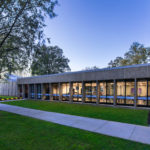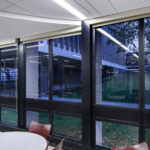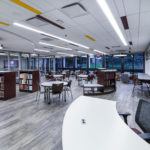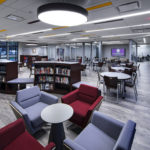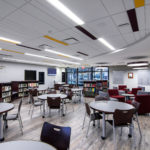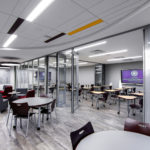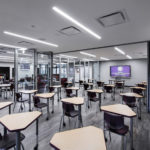Brother Henry S. Wright Learning Commons at Monsignor Farrell High School
Staten Island, NY
Project Description
The existing library had remained essentially unchanged for decades, and Msgr. Farrell decide that the time had come to bring the library into the 21st Century. With the advanced technologies available to students, and with the decrease in the amount of books contained in the library, the time has come to re-imagine how the library serves the students and the school at large and how the existing space can be used to maximum efficiency, which it currently is not. Monsignor Farrell HS is a Staten Island icon in both the world of education and architecture; the building is an excellent example of mid-century modern school architecture, designed by Charles Luckman; the library wants to be in the spirit of MCM as well as thoroughly 21st Century design. As an alumnus of the school – Class of 1983- I was honored to be given the commission.
The objective of the project was to attract new student enrollment and to serve current students and faculty better by providing a forward looking, state of the art high school Learning Commons that will provide the latest in technology for learning and have a modern design that is of its time, yet will be timeless like the rest of the building.The school has named the facility after Brother Henry S. Wright, who was a beloved teacher and who passed away in 2017.
The new Brother Henry S. Wright Learning Commons is the second step in the greening of the building, the first step being the recent installation of photovoltaic panels for solar power generation.
All of the materials specified for the project are green and sustainable.
- The flooring is low in VOC (volatile organic compound) emissions, consists of sustainable materials and can be recycled.
- The ceiling tiles consist of 80% recycled regional material content and meets sustainability standards for the sourcing of raw materials. The solid ceiling boards are made of 75% recycled content and meets/exceeds standards for construction waste management, the use of regional materials, biobased materials and design flexibility.
- The metal and glass walls allow natural light transmission from the exterior wall and both the aluminum and glass are sustainably produced and are recyclable.
- All of the lighting is LED, which is extremely energy efficient and generates very little heat; the lighting will be controlled by a state of the art computer control system giving maximum flexibility and efficiency. Even the old HVAC system will gain some new efficiency with the installation of modern electronic thermostats and modern air distribution diffusers.
- All of the paint is low VOC and waterborne
- The existing steel window frames will be carefully restored
- The existing, beautiful wood doors will be refinished with modern water based, low VOC stain.
The idea for the floor plan started with former Farrell Monsignor Whalen’s suggestion for metal and glass seminar rooms. With this mandate, we had to figure out how to organize the rest of the space and how to give it the flexibility that modern high school libraries require. I remembered that I read my first book on architecture in a comfortable chair near the storage room. The plan was organized on a diagonal from the point. The ceiling is another organizing element, with the curve of the ceiling making a place for the new book stacks and chairs for study. The corner where I read that first architecture book was made into a place to quietly read once again, secluded from the rest of the space by a curved wall that echoes the curve of the ceiling. The area of ceiling tiles is a riff on the current ceiling grid, which has 1’ wide tiles every 7’; the new ceiling will have 6”, 1’ and 2’ wide tiles in a repeating pattern, with a few maroon and gold tiles for accent and school pride.
